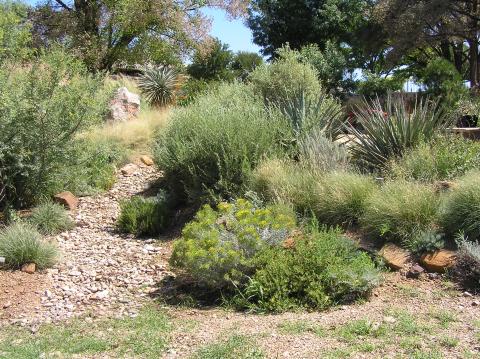
High Plains Gardening
The gardening website of the Texas High Plains Region
Rounding Out Our Native Plant Gardens
Yesterday, I posted information on my top local native wildflowers for the garden. Today, We'll top it off with shrubs, grasses and cacti to lend variety in shape, width and texture. Naturally, if you were planting and installing a garden, the trees and shrubs would go in first, before the herbaceous perennials and grasses. I'm only listing a few of  the many local native and southwest native plants available.
the many local native and southwest native plants available.
And don't forget several accent rocks. Accent rocks provide more than a visual element, but a vital part of the plant/garden community. Rocks and boulders provide shelter from wind, shade from the sun, store up heat in the winter and gather moisture as insurance between rainfalls. One never has to feed, water or treat the rocks for pest and disease, although you might find a snake hibernating under them, as I did this spring. Instead of freaking out, I was happy to provide an ecological niche. Of course, had it been a rattler, this would be a different story.
Local Native Shrubs for the Garden
Amorpha fruticosa, indigo bush, false indigo bush, 4-12' tall and wide, sun to part shade, dark blue-purple flowers with orange stamens in May. Fragrant. Butterflies love it, deer do not.
Artemisia filifolia, Sand Sage, Western native, grow on the dry side for better appearance. 3-6' tall.
Atriplex confertifolia, Shadscale. Semi-ever-green with gray leaves, low growing shrub, 2-3'T x 2-3'W. Some leaf drop in winter may occur.
Berberis trifoliata (Mahonia trifoliata), Agarita, Western native, evergreen (blue-green leaves) and prickly, grows to 8 feet. Makes a good screen. Yellow flowers in early spring.
Cercocarpus intracatus, C. montanus, C. ledifolium, Littleleaf mountain mahogany, Mountain Mahogany, and Curl-leaf Mountain Mahogany. Little leaf mountain mahogany is evergreen, the other two are decideous, growing up to 8'T x 4'W, with Mountain Mahogany capable of reaching up to 20'.
Chrysothamus nauseosus, Chamisa, rabbit bush, 4-6' x 6' wide, yellow fall flowers, fragrant.
Ephedra antisyphilitica, and other species, Mormon's Tea, green leafless stems, xeric, 4' x 3'. Unusual speciman shrub.
Faluga paradoxa, Apache Plume. Small green leaves on wiry branches. It's selling point is the white flowers and plumes spring to fall. Will grow to 6'T x 4'W, but can be pruned each spring to maintain a more compact shape.
Forestiera neomexicana, New Mexican privet, 8-10 ft. T x 6 ft. W Tall shrub with good branching structure and small green leaves. Very nice look in the landscape, a little larger, but similar in appearance to the Yaupon holly. Our native privet is F. pubescens, or the elbow bush.
Krascheninnikovia lanata, (previously Ceratoides lanata),Winterfat, 1-3' x 2-4', winter interest. Native to SW and Western US.
Rhus trilobata, three leaf sumac. Woody shrub up to 5'T x 4'W. Very nice look in the landscape.
Ribes aureum, Golden Current. Grows 3-6’T x 3-4’W in elevations 2500 – 8000’. Golden yellow flowers in early spring followed by edible red currents that ripen to blue-black by June-July. Cold hardy to -30° and drought tolerant.
Ribes cereum, Western Wax Currant, spring flowers and red summer berries, native to Western US. Habitat plant.
A Few Native Grasses for the Garden
Bouteloua gracilis, blue grama grass, native warm season perennial grass to the Short grass Prairies reaches about 12” tall. Mat forming with short rhizomes in our dry area it is mostly found in short tufts. Can be used as a lawn if mowed no lower than 4” and watered every other week. Not too particular about soil, requires less water than buffalo grass.
Bucheloe dactyloides, Buffalograss. Our North American native turfgrass, native to the shortgrass prairie and elevations below 7,000 ft. Sod forming warm season perennial grass grows to 4-6 inches tall. Spreads by stolons, will grow on most soils but prefers heavy clay soils to sand. Once a month mowing and watering, usually. Can be watered more often, if necessary.
Eragostis tricodes, Sand lovegrass. Native east of the Rockies to most of the US. Mid height clumping perennial grass. Lovely ornamental summer blooming grass. Will seed a bit.
Schizachyrium scoparium, little bluestem, Warm season clumping grass, mid height to 2-3' T.
Sporobolus airoides, Alkali sacaton. Native perennial warm season tufted grass. Airy seed particles stand tall above the leaves. Will grow in clay, alkaline and saline soils as well as silty loam. Heat and drought tolerant.
Local Native Cold Hardy Cacti
Coryphantha missouriensis, nipple cactus
Coryphantha vivipara, pincushion or ball cactus
Cylindropuntia whipplei, dwarf pencil cholla, plateau cholla
Echinocactus texensis, Horse crippler
Echinocereus coccineus, Texas claret cup cactus, very showy, up to 12-15 inches.
Echinocereus fendlerii, Fendler's hedgehog
Echinocereus fendleri rectispinus, pink flowered Fendler's hedgehog cactus
Echinicereus reichenbachii, and E. reichenbachii var. albispinus, lace cactus; white spined lace cactus
Mammillaria heyderi, nipple cactus
Opuntia engelmannii, Engelmann's prickly pear
Opuntia imbricata, Cane cactus, tree cactus, cholla
Opuntia kleiniae, candle cholla
Opuntia leptocaulis, Tasajillo, pencil cactus
Opuntia macrorhiza, plains prickly pear
Opuntia phaeacantha major, Santa Fe prickly pear, brown spined prickly pear
Opuntia polyacantha, Hunger cactus, very spiny
Our native yucca is Yucca glauca. I don't recommend planting it in the garden because it is invasive. There are many non-local native yuccas to choose from that won't become a problem. Alas, I've never heard of a local native agave, but there are any number of agaves that are cold hardy for the Texas Panhandle.
Tomorrow, I'll post about amending the soil for a native plant garden.
Angie Hanna, May 8, 2013